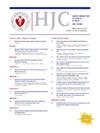高出血风险患者植入药物洗脱支架后缺血性心血管和出血预后的性别差异
IF 3
3区 医学
Q2 CARDIAC & CARDIOVASCULAR SYSTEMS
引用次数: 0
摘要
背景高出血风险(HBR)患者在植入药物洗脱支架(DES)后可能会表现出不确定的双联抗血小板疗法(DAPT)依从性。本项基于人群的队列研究旨在通过分析台湾的国民健康保险研究数据库,研究高出血风险人群不良结局的性别差异。方法入选的患者具有学术研究联盟(ARC)定义的高出血风险特征,并在2007年1月1日至2017年12月31日期间接受了DES植入术。采用倾向得分匹配法选择了3981对临床心血管风险相似但性别不同的患者。采用竞争风险模型评估了两性发生不良缺血性事件(心源性死亡、非致死性心肌梗死和缺血性中风)和任何出血事件的风险。结果在5年的随访中,男性综合缺血事件和任何出血事件的发病率(每千人年,95%置信区间(CI))分别为44.09(40.25-48.30)和42.55(38.79-46.68),而女性分别为40.18(36.51-44.23)和42.35(38.57-46.51)。在对临床变量进行调整后,与女性患者相比,男性患者发生复合缺血性事件的风险略有增加(调整后的亚分布危险比 (SHR) = 1.15 (1.00-1.31),p = 0.045),发生任何出血事件的风险相似(调整后的 SHR = 1.00 (0.88-1.15),p = 0.946)。本文章由计算机程序翻译,如有差异,请以英文原文为准。


Sex-based differences in ischemic cardiovascular and bleeding outcomes following implantation of drug-eluting stent in patients at high bleeding risk
Background
Patients with high bleeding risk (HBR) may exhibit uncertain adherence to dual antiplatelet therapy (DAPT) following drug-eluting stent (DES) implantation. The current population-based cohort study aimed to investigate the sex-based differences in adverse outcomes among the HBR population by analyzing the National Health Insurance Research Database in Taiwan.
Methods
Patients who had HBR features defined by the Academic Research Consortium (ARC) and received DES implantation between January 1, 2007, and December 31, 2017, were enrolled. Propensity score matching was adopted to select 3,981 pairs with similar clinical cardiovascular risks but different sexes. A competing risk model was performed to evaluate the risk of adverse ischemic events (cardiac death, nonfatal myocardial infarction, and ischemic stroke) and any bleeding events in both sexes. Noncardiac death was considered a competing risk.
Results
Within a 5-year follow-up, the incidence rates (per 1,000 person-year (95% confidence interval (CI)) of composite ischemic events and any bleeding events in males were respectively 44.09 (40.25–48.30) and 42.55 (38.79–46.68), while those in females were respectively 40.18 (36.51–44.23) and 42.35 (38.57–46.51). After adjustment for clinical variables, male patients had a marginally increased risk in the composite ischemic events (adjusted subdistribution hazard ratio (SHR) = 1.15 (1.00–1.31), p = 0.045) and a similar risk of any bleeding events (adjusted SHR = 1.00 (0.88–1.15), p = 0.946) compared with female patients.
Conclusions
Of the HBR population, males had an increased risk of ischemic outcomes but a similar risk of bleeding compared with females following DES implantation.
求助全文
通过发布文献求助,成功后即可免费获取论文全文。
去求助
来源期刊

Hellenic Journal of Cardiology
CARDIAC & CARDIOVASCULAR SYSTEMS-
CiteScore
4.90
自引率
7.30%
发文量
86
审稿时长
56 days
期刊介绍:
The Hellenic Journal of Cardiology (International Edition, ISSN 1109-9666) is the official journal of the Hellenic Society of Cardiology and aims to publish high-quality articles on all aspects of cardiovascular medicine. A primary goal is to publish in each issue a number of original articles related to clinical and basic research. Many of these will be accompanied by invited editorial comments.
Hot topics, such as molecular cardiology, and innovative cardiac imaging and electrophysiological mapping techniques, will appear frequently in the journal in the form of invited expert articles or special reports. The Editorial Committee also attaches great importance to subjects related to continuing medical education, the implementation of guidelines and cost effectiveness in cardiology.
 求助内容:
求助内容: 应助结果提醒方式:
应助结果提醒方式:


